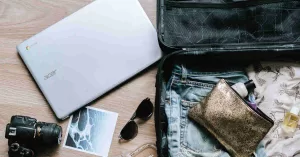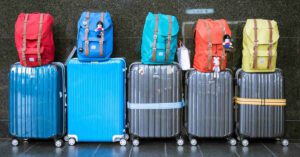When traveling by air, it’s important to be aware of the regulations regarding the transportation of electronics in checked luggage. The Federal Aviation Authority (FAA) has established specific rules to ensure the safety and security of all passengers.
In this post, we’ll explain what electronics that are generally not allowed in checked luggage.
- Why Are Some Electronics Not Allowed in Checked Luggage?
- Electronics Allowed in Carry On Baggage
- Electronics Not Allowed in Checked Luggage
- Check Airline and TSA Guidelines
- How to Pack Electronics in Checked Luggage
- Final Thoughts
Why Are Some Electronics Not Allowed in Checked Luggage?
The main reason why some electronics are prohibited in checked luggage is because of the potential fire hazard they pose.
Lithium batteries, which are commonly used in laptops, tablets, smartphones, cameras, and other devices, can overheat, catch fire, or explode if they are damaged, short-circuited, or exposed to extreme temperatures or pressure.
This can cause a serious safety risk for the passengers and crew on board the plane, as well as damage to the cargo and baggage compartments.
According to the Federal Aviation Administration (FAA), there have been at least 450 incidents involving lithium batteries in air cargo or baggage since March 2006.
Some of these incidents have resulted in injuries, fires, and emergency landings. To prevent such accidents from happening, the FAA and the Transportation Security Administration (TSA) have issued strict regulations on how to transport lithium batteries and devices containing them.
Electronics Allowed in Carry On Baggage
It’s important to note that most electronic devices are allowed in carry-on baggage, where both passengers and airline staff can safely keep an eye on them.
This includes items like:
- Smartphones
- Tablets
- Laptops
- E-readers
- Cameras
- Portable gaming consoles
- Power banks
However, these devices must undergo separate screening at the security checkpoint.
Electronics Not Allowed in Checked Luggage
While the following electronics are generally allowed in carry-on baggage, they are prohibited in checked luggage due to their potential risks:
Lithium Batteries
Lithium batteries are commonly used in electronic devices and can pose safety risks if mishandled or damaged. For this reason, there are restrictions on the transportation of certain lithium batteries in checked luggage:
Spare Lithium Batteries
Spare lithium batteries (those not installed in a device) aren’t allowed in checked luggage.
Examples of these batteries include:
- Power bank
- External chargers
- High-capacity laptop batteries.
However, these batteries are generally allowed in carry-on luggage, depending on their power rating:
| Power Rating | Allowed in Baggage? |
|---|---|
| Up to 100 Wh | Allowed in carry-on only |
| From 101 to 160 Wh | Up to 2 batteries allowed in carry-on only, subject to prior approval from your airline |
| Exceeding 160 Wh | Not allowed in carry-on or checked baggage |
How to Calculate the Power Rating of Lithium Batteries
The power rating of a lithium battery is measured in watt-hours (Wh), which is the product of the battery voltage and the battery capacity in amp-hours (Ah).
To calculate the Wh of a lithium battery, you can use this formula:
Wh = V x Ah
For example, a 12 V lithium battery with a 50 Ah capacity has a power rating of 600 Wh. The power rating indicates how much energy the battery can store and deliver over time.
The capacity of your battery may be expressed in mAh. In this case, you would use the same formula as above but divide the result by 1,000:
Wh = V x mAh ÷ 1,000
E-Cigarettes and Vaping Devices
E-cigarettes, vape pens, and other similar devices often contain lithium batteries and aren’t allowed in checked luggage due to the risk of fire.
The TSA prohibits them from being packed in checked luggage and requires that they must be carried in your carry-on bag. You should also make sure that they are turned off and protected from accidental activation.
Smart Luggage with Batteries
Smart bags, which are suitcases or backpacks with built-in charging capabilities, GPS tracking, or other electronic features, usually contain lithium batteries.
If the lithium batteries can’t be removed, these bags aren’t allowed in checked luggage. However, if the battery is removable, it can be carried in the cabin, and the bag can be checked.
Samsung Galaxy Note 7
Samsung recalled this smartphone model due to a defect that caused some of them to explode or catch fire.
You cannot bring this device on any flight, either in your checked or carry-on luggage.
Hoverboards and Self-Balancing Scooters
Hoverboards and Segways, which are self-balancing electric scooters, are prohibited in both checked and carry-on luggage due to their lithium-ion batteries.
These batteries have been known to catch fire or explode, presenting a significant safety concern.
Power Tools
Power tools, such as drills, saws, and nail guns that are powered by lithium batteries, are generally not allowed in checked luggage.
These tools often have larger battery packs that exceed the watt-hour rating permitted for spare batteries.
Personal Electronic Devices (PEDs)
Personal electronic devices, such as laptops, tablets, smartphones, and cameras, are generally allowed in both checked and carry-on luggage.
However, it’s highly recommended to pack them in your carry-on baggage for safekeeping and convenience.
Many airlines have restrictions on the number of spare lithium batteries that can be carried in your cabin baggage, so it’s important to check with your specific airline for their policies.
Other Electronic Devices Containing Lithium Batteries
Sometimes, it’s not apparent that a device contains lithium batteries. Essentially, if your device requires charging to be used, or is used cordlessly, there’s a good chance that it’s powered by a lithium battery.
Examples of other electronics that may contain lithium batteries include:
- Camcorders
- Portable speakers
- Wireless headphones
- Electric toothbrushes
- Electric razors
- Cordless hair dryers
- Cordless curling irons
- Drones
- Motorized bicycles
- Electric scooters
Check Airline and TSA Guidelines
It’s important to review the specific guidelines provided by both the airline and TSA before your flight, as regulations may change.
Each airline might have its own additional restrictions, so it’s best to consult their website or contact them directly.
How to Pack Electronics in Checked Luggage
Although we strongly advise against packing electronics in checked baggage, due to their fragile nature and risk of theft, we understand that there are circumstances when you may choose to do so.
Ok, confession time…A little over ten years ago, I took a trip from Melbourne, Australia to Barbados in the Caribbean. It was going to be an extended vacation – I was planning to stay for approximately six months, so I wanted to bring some of my favorite movies and TV shows to watch during my downtime.
So, I packed two 1-terabyte hard drives in my checked baggage (I was young and foolish – now, no longer young…). Remember, these were bulky, mechanical hard drives, not the SSD drives that are commonplace today.
They managed to survive the 40+ hour, 3-flight itinerary (MEL – LAX – MIA – BGI)!
Would I do that again? NO WAY!
Here are some tips on how to pack electronics in checked luggage:
Choose a Sturdy and Lockable Suitcase
You want to avoid using soft or flimsy bags that can be easily ripped or cut open. A hard-shell suitcase with a TSA-approved lock is a good option, as it will provide more protection and security for your electronics.
You can also use a luggage strap or a cable tie to secure the zipper of your suitcase.
Wrap Your Electronics in Bubble Wrap or Clothing
You don’t want your electronics to move around or bump into each other inside your suitcase, as this can cause scratches, dents, or cracks. You can use bubble wrap, towels, sweaters, or other soft items to wrap your electronics and cushion them from impact.
Make sure to cover the screens, buttons, and ports of your devices with bubble wrap or tape to prevent dust or moisture from getting in.
Place Your Electronics in the Middle of Your Suitcase
You want to avoid putting your electronics near the edges or corners of your suitcase, as these are the most vulnerable areas to damage from external pressure or shock.
You can place your electronics in the middle of your suitcase, surrounded by clothing or other items that can act as padding.
You can also use packing cubes, ziplock bags, or pouches to organize your electronics and keep them separate from each other.
Check the TSA and Airline’s Rules and Regulations for Packing Electronics
You want to make sure you are following the TSA and your airline’s policies and guidelines for packing electronics in your checked luggage.
No airline’s baggage policy is the same, and this applies to their list of prohibited items in checked baggage.
Important: Airlines are responsible for any damage that may occur to your luggage and its contents while your bags are in their custody
However, airlines are typically not liable for fragile and valuable items packed in luggage, such as electronics.
Final Thoughts
Electronics prohibited in checked luggage are mainly those that contain lithium metal or lithium-ion batteries, which can pose a fire hazard if they are damaged, short-circuited, or exposed to extreme temperatures or pressure.
To avoid any problems at the airport or on board the aircraft, you should pack these devices in your carry-on bags and follow the rules and guidelines set by the FAA and the TSA.
You should also check with your airline for any additional restrictions or requirements before traveling.
Sources:



